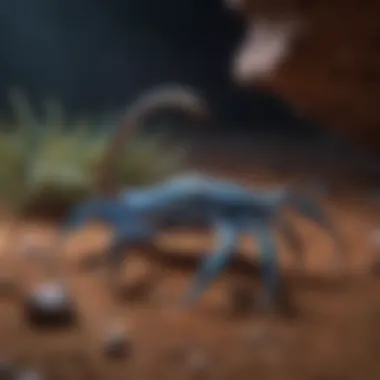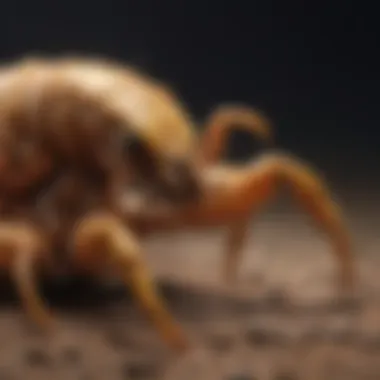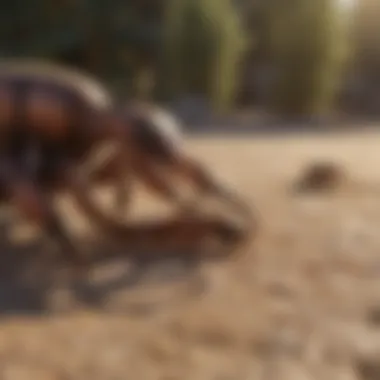Unlocking the Enigma of Arizona's Diverse Scorpions


Preventive Pest Control Strategies
When it comes to safeguarding your home against common scorpions in Arizona, implementing proactive pest control strategies is crucial. This section will delve into essential tips and methods to prevent scorpions and other pests from invading your living spaces.
House Exterior Protection
To begin, focus on fortifying the exterior of your house to create a barrier against intruding pests. Seal cracks and crevices meticulously, ensuring no entry points are left unchecked. Additionally, regularly clear debris and clutter from around the perimeter of your home to eliminate potential hiding spots for scorpions.
Yard Maintenance
Maintaining a well-groomed yard is paramount for pest control. Consistent yard care routines such as mowing the lawn, trimming bushes, and removing standing water are effective practices in deterring scorpions and other unwanted insects. Implement methods like using pest-repelling plants to keep your yard pest-free.
Indoor Cleanliness
Indoor spaces should be kept impeccably clean to discourage pest infestations. Follow expert cleaning tips and techniques to ensure a pest-resistant environment inside your home. Regular vacuuming, dusting, and clutter reduction are simple yet powerful measures in pest prevention.
Garbage Disposal
Proper waste disposal is essential in controlling pests. Adopt efficient garbage disposal methods, such as using sealed trash bins and disposing of waste regularly. Maintaining cleanliness in and around trash receptacles can help deter scorpions and other pests from scavenging for food.
Other Pest Prevention Strategies
Beyond the basics, explore innovative ways to enhance your home's defenses against pests. This may involve using natural repellents like citrus peels or vinegar sprays, setting up ultrasonic pest repellent devices, or installing physical barriers like door sweeps and window screens.
Identifying Pest Risk Areas
Before implementing pest control measures, it's vital to identify potential risk areas in and around your home where pests, including scorpions, may gain entry. This section will guide you through thorough inspections and proactive steps to mitigate these risks effectively.
Moisture Prone Areas Inspection
Inspect areas prone to moisture accumulation, such as under sinks, around plumbing fixtures, and near water sources. Addressing damp conditions promptly and utilizing dehumidifiers can help prevent pest infestations attracted to moisture.
Crack and Crevice Inspection Guide
Examine cracks and crevices throughout your home to seal off potential entry points for scorpions and other pests. Use sealants like silicone caulk to fill gaps around windows, doors, and foundation walls, reducing opportunities for pest intrusion.
Greenery Inspection for Pest Risks
The vegetation surrounding your home can either attract or deter pests. Understand how greenery impacts pest presence, and take steps to maintain a well-manicured landscape to minimize harborage areas for scorpions. Trim bushes and foliage away from the house to create a pest-free buffer zone.
Additional Pest Risk Areas
In addition to common pest entry points, identify and address miscellaneous areas that pose potential risks. This may include examining attic spaces, securing outdoor storage areas, and inspecting crawl spaces for signs of pest activity. By being thorough in your assessments, you can fortify your home against diverse pest threats.
Effective Pest Control Methods
While prevention is key, having effective pest control methods in place is imperative for tackling infestations swiftly and decisively. This section will outline various approaches, from natural repellents to chemical sprays, offering a comprehensive toolkit for managing pests.
Natural Repellents for Pest Control
Utilize safe and eco-friendly natural repellents to deter pests without harming the environment or your health. Essential oils like peppermint, lavender, and eucalyptus can be potent allies in repelling scorpions and other insects. Consider planting pest-deterring herbs like basil and rosemary in your garden as an additional preventive measure.
Chemical Sprays for Pest Control
In cases where pest infestations require more intensive intervention, professional-grade chemical sprays may be necessary. When using chemical solutions, always follow safety guidelines and consider seeking assistance from pest control professionals for complex issues.
Pest Traps: Effective Pest Control Solutions
Strategically place pest traps around your home to capture and eliminate scorpions and other pests. Traps can be an efficient way to monitor pest activity and reduce populations indoors and outdoors. Regularly check and reset traps to maximize their efficacy.


Biological Control Methods for Pest Prevention
Harnessing natural predators as a form of pest control can be a sustainable and environmentally friendly option. Introducing beneficial predators like ladybugs or maintaining bird feeders to attract insect-eating birds can help keep pest populations in check naturally.
Other Pest Control Methods
Explore unconventional pest control methods beyond traditional approaches. This may include deploying electronic pest repellers, utilizing pheromone traps, or implementing sound wave devices to deter pests. Experiment with different techniques to find the most effective combination for your pest management needs.
Pest Species Identification
Understanding the various pest species that pose a threat to your home is essential for targeted pest control strategies. This section will equip you with insights into common insects, rodents, birds, and wildlife that may encroach on your living spaces.
Common Insects in Home Pest Control
Learn to identify and manage prevalent insect invaders like ants, cockroaches, and spiders. Each insect species has distinct behaviors and preferences, necessitating tailored approaches for effective eradication and prevention.
Identifying Rodents for Pest Prevention
Rodents such as mice and rats can wreak havoc on properties if left unchecked. Recognize signs of rodent activity, seal off entry points that rodents exploit, and consider using bait stations or trapping methods to curb rodent populations.
Bird Species Impacting Home Environments
Birds can pose challenges with nesting, droppings, and property damage. Address common bird-related issues by bird-proofing your home with deterrents like visual scare devices or netting. Understanding the behavior of problematic bird species can aid in devising humane yet effective control measures.
Dealing with Wildlife on Your Property
Encounters with wildlife species like raccoons, squirrels, or skunks can pose safety risks and property damage concerns. Navigate these situations by avoiding attracting wildlife with food sources, securing trash cans, and consulting wildlife experts for assistance in humane wildlife management.
Miscellaneous Pest Species Identification
While some pest species may be less familiar, they can still impact your home environment. Research and identify lesser-known pests like pantry moths, carpet beetles, or silverfish to address infestations promptly and effectively.
DIY Pest Control Techniques
Empowering homeowners with do-it-yourself pest control techniques can be a cost-effective and empowering approach to managing pest issues. This section will impart practical DIY solutions utilizing accessible materials and methods for pest prevention.
Homemade Pest Control Solutions
Craft eco-friendly pest control remedies using ingredients commonly found in your kitchen. Ingredients like vinegar, baking soda, and citrus extracts can serve as potent repellents against pests while being safe for household use.
Using Essential Oils for Pest Control
Harness the power of essential oils to repel pests naturally. Create aromatic blends of oils like citronella, tea tree, or cedarwood to keep insects at bay. Diffusing essential oils indoors can not only enhance your living environment but also deter pests effectively.
Effective Pest Traps and Barriers
Fabricate homemade pest traps and barriers using everyday materials such as cardboard, sticky tapes, or mesh screens. Position these traps strategically in areas prone to pest activity to intercept and contain pests before they become a nuisance.
Top Reputable Pest Control Brands
Explore reputable brands offering a range of pest control products tailored to home use. Opt for solutions from trusted companies known for their efficacy and safety in managing pest infestations. From repellents to traps, choosing quality products can enhance your pest control efforts.
Miscellaneous DIY Pest Control Techniques
Dive into a plethora of DIY pest control methods that cater to specific pest issues at home. Whether it's constructing physical barriers to prevent entry or concocting natural deterrents to repel pests, there are myriad inventive solutions to explore for a pest-free living environment.
Introduction
In the vast expanse of the Arizona desert, the intriguing world of scorpions unfolds, showcasing a variety of species with unique characteristics, habitats, and behaviors. This article serves as a portal into the realm of these arachnids, shedding light on their significance within the ecosystem and their potential interactions with humans. By delving into the depths of common scorpions in Arizona, readers will embark on a captivating journey of discovery and understanding.


Brief Overview of Scorpions
Physical Features
Scorpions boast an array of distinct physical features, including their segmented bodies, venomous stingers, and pincer-like claws. These attributes are essential for their survival in the harsh desert environment, enabling them to hunt, defend themselves, and navigate their surroundings effectively. The armored exoskeleton of scorpions provides them with protection against predators and environmental hazards, exemplifying their remarkable adaptation to arid landscapes.
Life Cycle
The life cycle of scorpions encompasses several stages, from birth to maturity, showcasing their resilience and reproductive strategies. Female scorpions give birth to live young, contrasting them with most arthropods that lay eggs. This viviparous reproductive method enhances the survival chances of scorpion offspring in harsh desert conditions, where resources are scarce and competition is fierce. Their ability to adapt their reproductive processes to challenging environments is a testament to their evolutionary prowess.
Importance in the Ecosystem
Scorpions play a vital role in the ecosystem as efficient predators that help control insect populations. By preying on various insects, scorpions help maintain ecological balance and reduce pest populations in their habitats. Additionally, scorpions serve as a food source for other wildlife, contributing to the intricate web of interactions within desert ecosystems. Their ecological significance underscores the importance of understanding and conserving these enigmatic arachnids.
Arizona as a Scorpion Habitat
Geographical Distribution
The geographical distribution of scorpions in Arizona is influenced by factors such as temperature, moisture levels, and habitat availability. Different species exhibit preferences for specific regions within the state, with some thriving in arid, rocky terrains while others prefer sandy desert environments. Understanding the geographical distribution of scorpions is essential for conserving their populations and studying their behaviors in diverse habitats.
Preferred Environments
Scorpions thrive in a range of environments, from desert scrublands to mountainous regions, where they adapt to extreme temperatures and limited water resources. In Arizona, scorpions seek shelter in burrows, rock crevices, and under debris during the day to avoid heat stress and conserve energy. Their ability to inhabit diverse landscapes highlights their adaptability and survival strategies in harsh desert conditions.
Common Scorpion Species in Arizona
In this section, we delve into the significance of exploring common scorpion species in Arizona. By focusing on specific elements such as physical features, behavioral patterns, and venom potency, readers will gain a comprehensive understanding of these arachnids. This detailed exploration provides insights into the diverse scorpion population in Arizona, shedding light on their role within the ecosystem and potential interactions with humans.
Bark Scorpion (Centruroides sculpturatus)
Description and Identification
The bark scorpion is known for its slender body and light brown coloration, making it easily identifiable. Its size, ranging from 2-3 inches, along with its two narrow pincers and segmented tail with a stinger, distinguish it from other scorpion species. The importance of its description and identification lies in aiding researchers and enthusiasts in correctly identifying this species, crucial for research and safety purposes.
Behavioral Patterns
Bark scorpions exhibit nocturnal behavior, hunting for prey during the night and seeking shelter during the day. This unique behavioral pattern provides insights into their predatory strategies and survival tactics in the harsh desert environment. Understanding their behavior is essential for both scientific study and mitigating potential encounters with humans.
Venom Potency
The bark scorpion possesses potent venom, considered medically significant, especially for children and the elderly. Its venom can cause severe reactions in humans, making it a species of interest for medical research and antivenom development. Studying the venom potency of the bark scorpion is pivotal in enhancing our knowledge of its impact on human health.
Stripe-Tailed Scorpion (Paravaejovis striatus)
Characteristics and Habitat
The stripe-tailed scorpion is characterized by its striped tail pattern and preference for rocky desert habitats. Understanding its unique physical characteristics and habitat preferences provides valuable insights into its ecological niche and adaptation to the Arizona landscape. By studying its habitat, researchers can unravel its role in the ecosystem.
Dietary Preferences
Stripe-tailed scorpions primarily feed on insects, using their pincers and venomous sting to capture prey. Their dietary preferences contribute to the regulation of insect populations in their habitats, showcasing their ecological importance. Exploring their feeding habits sheds light on their role as predators in the desert environment.
Giant Desert Hairy Scorpion (Hadrurus arizonensis)
Distinctive Features
The giant desert hairy scorpion is known for its large size, hairy appearance, and robust claws, making it visually distinct from other scorpion species. Its unique features serve both defensive and predatory purposes, highlighting its evolutionary adaptations for survival in the desert. Studying its distinctive traits aids in understanding its ecological niche and predator-prey interactions.
Reproduction Methods


Giant desert hairy scorpions reproduce through a process known as sexual reproduction, involving courtship rituals and mating behaviors. Their reproductive methods, including gestation periods and offspring care, offer insights into their life cycle and population dynamics. Researching their reproduction sheds light on the species' reproductive strategies and genetic diversity.
Arizona Bark Scorpion (Centruroides exilicauda)
Ecological Role
The Arizona bark scorpion plays a vital role in maintaining ecological balance by preying on small insects and contributing to the regulation of arthropod populations. Its presence in the ecosystem influences food webs and biodiversity, showcasing its significance in desert ecosystems. Understanding its ecological role is essential for conservation efforts and ecosystem management.
Human Interactions
Human interactions with the Arizona bark scorpion often involve sting incidents, highlighting the importance of education and preventive measures. Awareness of scorpion habitats and behavior can reduce the risk of encounters with this species, enhancing human safety in scorpion-prone areas. Through educational outreach and research, mitigating negative interactions with humans can be achieved.
Behavioral Patterns and Adaptations
Behavioral patterns and adaptations play a crucial role in understanding the world of scorpions in Arizona. These arachnids have developed intricate behaviors and physiological adaptations to thrive in their unique environment. By delving into their behaviors and adaptations, we can gain a profound insight into how scorpions navigate their ecosystem and interact with their surroundings.
Nocturnal Activities
Hunting Strategies:
Hunting strategies employed by scorpions are key to their survival and predation techniques. Scorpions, being nocturnal hunters, use their keen senses to locate prey efficiently during nighttime. Their hunting strategies involve stealthily approaching their prey and utilizing their venomous sting to subdue them. This methodical approach allows scorpions to secure their food source effectively in the darkness, showcasing their adaptability to low-light conditions.
Sheltering Behaviors:
Sheltering behaviors adopted by scorpions are essential for their survival and protection. These arachnids seek out suitable shelters during daylight hours to avoid extreme temperatures and potential predators. By utilizing crevices, burrows, or vegetation cover, scorpions ensure their safety and regulate their body temperature effectively. Their sheltering behaviors showcase their adaptive nature and ability to find refuge in challenging desert landscapes.
Thermoregulation Techniques
Survival Mechanisms:
Scorpions demonstrate remarkable survival mechanisms through their thermoregulation techniques. These arachnids can adjust their metabolic processes to withstand fluctuating temperatures, ensuring their physiological functions remain optimal. By conserving energy during periods of extreme heat or cold, scorpions showcase their ability to adapt to harsh environmental conditions efficiently.
Seasonal Adjustments:
Seasonal adjustments play a vital role in the life cycle of scorpions inhabiting Arizona. These arachnids exhibit behavioral changes and adaptations based on the shifting seasons. During the hot summer months, scorpions may burrow deeper into the ground to escape the heat, while in the cooler winter months, they may become less active to conserve energy. These seasonal adjustments highlight the resilience and flexibility of scorpions in adapting to the dynamic desert climate.
Interactions with Humans
In the realm of scorpions inhabiting Arizona, understanding their interactions with humans is paramount. These interactions hold a vital place in this article as they shed light on the significance of coexisting with these creatures. The adaptations and behaviors of scorpions in response to human presence provide intriguing insights into these arachnids' survival strategies. Moreover, delving into the ways humans can navigate encounters with scorpions is crucial for fostering harmony between the two species.
Sting Incidents
Treatment Procedures
When discussing treatment procedures for scorpion sting incidents, a comprehensive approach is essential for addressing the potential risks associated with these encounters. Implementing prompt and appropriate medical care is key to mitigating the effects of scorpion venom on humans. From administering antivenom to managing symptoms such as pain and swelling, treatment procedures play a pivotal role in ensuring the well-being of individuals affected by scorpion stings. Understanding the step-by-step process of treating scorpion envenomation is critical for healthcare professionals and individuals alike.
One unique feature of treatment procedures in this context is the emphasis on tailored interventions based on the severity of the sting. Applying specific protocols for different levels of envenomation underscores the importance of personalized medical attention in managing scorpion sting incidents effectively. By highlighting the efficiency and success rates of these treatment procedures, this article aims to equip readers with valuable insights into handling such emergencies.
Preventive Measures
In the realm of scorpions inhabiting Arizona, preventive measures serve as the front line of defense against potential sting incidents. Educating individuals about scorpion behavior and habitats is instrumental in reducing the likelihood of unfortunate encounters. From ensuring proper housing insulation to employing caution in outdoor settings, preventive measures empower humans to coexist safely with scorpions.
A unique aspect of preventive measures is their proactive nature, aiming to preemptively address the risks associated with scorpion presence in residential or natural environments. By emphasizing awareness and preparedness, this article advocates for a proactive stance in preventing scorpion stings and fostering a harmonious relationship between humans and these arachnids.
Educational Significance
Research Opportunities
The educational significance of scorpion research opportunities in Arizona extends far beyond a mere academic pursuit. Conducting studies on scorpion behavior, venom properties, and ecological impacts not only enhances our understanding of these creatures but also contributes to broader scientific knowledge. Research opportunities present a pathway to uncovering novel insights into scorpions' adaptations and interactions with their environment.
One key characteristic of research opportunities lies in their interdisciplinary nature, bridging fields such as biology, ecology, and pharmacology to unravel the complexities of scorpion biology. By exploring the underexplored facets of scorpion biology through research endeavors, scientists strive to unravel the mysteries surrounding these fascinating arachnids and their evolutionary significance.
Conservation Efforts
In the realm of conservation efforts related to scorpion species in Arizona, ensuring the preservation of these creatures' habitats and populations is of utmost importance. Implementing conservation strategies aimed at protecting scorpions from habitat loss and human encroachment plays a critical role in safeguarding their biodiversity. Conservation efforts are essential for maintaining the delicate ecological balance in regions where scorpions play a significant role.
A unique feature of conservation efforts is their collaborative nature, involving scientists, policymakers, and local communities in fostering sustainable practices that benefit both scorpions and their habitats. By advocating for conservation initiatives that prioritize the long-term well-being of scorpion species, this article aims to instill a sense of responsibility and stewardship towards these enigmatic creatures.



